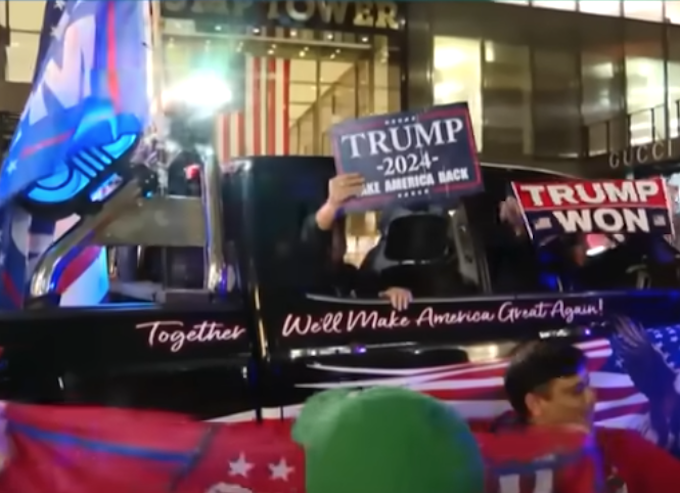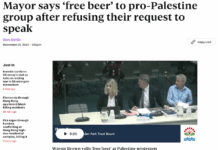
ANALYSIS: By Julie Posetti, City St George’s, University of London and Waqas Ejaz, University of Oxford
Press freedom is a pillar of American democracy. But political attacks on US-based journalists and news organisations pose an unprecedented threat to their safety and the integrity of information.
Less than 48 hours before election day, Donald Trump, now President-elect for a second term, told a rally of his supporters that he wouldn’t mind if someone shot the journalists in front of him.
“I have this piece of glass here, but all we have really over here is the fake news. And to get me, somebody would have to shoot through the fake news. And I don’t mind that so much,” he said.
A new survey from the International Center for Journalists (ICFJ) highlights a disturbing tolerance for political bullying of the press in the land of the First Amendment. The findings show that this is especially true among white, male, Republican voters.
We commissioned this nationally representative survey of 1020 US adults, which was fielded between June 24 and July 5 2024, to assess Americans’ attitudes to the press ahead of the election. We are publishing the results here for the first time.
More than one-quarter (27 percent) of the Americans we polled said they had often seen or heard a journalist being threatened, harassed or abused online. And more than one-third (34 percent) said they thought it was appropriate for senior politicians and government officials to criticise journalists and news organisations.
Tolerance for political targeting of the press appears as polarised as American society. Nearly half (47 percent) of the Republicans surveyed approved of senior politicians critiquing the press, compared to less than one-quarter (22 percent) of Democrats.
Our analysis also revealed divisions according to gender and ethnicity. While 37 percent of white-identifying respondents thought it was appropriate for political leaders to target journalists and news organisations, only 27 percent of people of colour did. There was also a nine-point difference along gender lines, with 39 percent of men approving of this conduct, compared to 30 percent of women.
It appears intolerance towards the press has a face — a predominantly white, male and Republican-voting face.
Press freedom fears
This election campaign, Trump has repeated his blatantly false claim that journalists are “enemies of the people”. He has suggested that reporters who cross him should be jailed, and signalled that he would like to revoke broadcast licences of networks.
Relevant, too, is the enabling environment for viral attacks on journalists created by unregulated social media companies which represent a clear threat to press freedom and the safety of journalists. Previous research produced by ICFJ for Unesco concluded that there was a causal relationship between online violence towards women journalists and physical attacks.
While political actors may be the perpetrators of abuse targeting journalists, social media companies have facilitated their viral spread, heightening the risk to journalists.
We’ve seen a potent example of this in the current campaign, when Haitian Times editor Macollvie J. Neel was “swatted” — meaning police were dispatched to her home after a fraudulent report of a murder at the address — during an episode of severely racist online violence.
The trigger? Her reporting on Trump and JD Vance amplifying false claims that Haitian immigrants were eating their neighbours’ pets.
Trajectory of Trump attacks
Since the 2016 election, Trump has repeatedly discredited independent reporting on his campaign. He has weaponised the term “fake news” and accused the media of “rigging” elections.
“The election is being rigged by corrupt media pushing completely false allegations and outright lies in an effort to elect [Hillary Clinton] president,” he said in 2016. With hindsight, such accusations foreshadowed his false claims of election fraud in 2020, and similar preemptive claims in 2024.
His increasingly virulent attacks on journalists and news organisations are amplified by his supporters online and far-right media. Trump has effectively licensed attacks on American journalists through anti-press rhetoric and undermined respect for press freedom.
In 2019, the Committee to Protect Journalists found that more than 11 percent of 5400 tweets posted by Trump between the date of his 2016 candidacy and January 2019 “. . . insulted or criticised journalists and outlets, or condemned and denigrated the news media as a whole”.
After being temporarily deplatformed from Twitter for breaching community standards, Trump launched Truth Social, where he continues to abuse his critics uninterrupted. But he recently rejoined the platform (now X), and held a series of campaign events with X owner and Trump backer Elon Musk.
The failed insurrection on January 6, 2021, rammed home the scale of the escalating threats facing American journalists. During the riots at the Capitol, at least 18 journalists were assaulted and reporting equipment valued at tens of thousands of dollars was destroyed.
This election cycle, Reporters Without Borders logged 108 instances of Trump insulting, attacking or threatening the news media in public speeches or offline remarks over an eight-week period ending on October 24.
Meanwhile, the Freedom of the Press Foundation has recorded 75 assaults on journalists since January 1 this year. That’s a 70 percent increase on the number of assaults captured by their press freedom tracker in 2023.
A recent survey of hundreds of journalists undertaking safety training provided by the International Women’s Media Foundation found that 36 percent of respondents reported being threatened with or experiencing physical violence. One-third reported exposure to digital violence, and 28 percent reported legal threats or action against them.
US journalists involved in ongoing ICFJ research have told us that they have felt particularly at risk covering Trump rallies and reporting on the election from communities hostile towards the press. Some are wearing protective flak jackets to cover domestic politics. Others have removed labels identifying their outlets from their reporting equipment to reduce the risk of being physically attacked.
And yet, our survey reveals a distinct lack of public concern about the First Amendment implications of political leaders threatening, harassing, or abusing journalists. Nearly one-quarter (23 percent) of Americans surveyed did not regard political attacks on journalists or news organisations as a threat to press freedom. Among them, 38 percent identified as Republicans compared to just 9 percent* as Democrats.
The anti-press playbook
Trump’s anti-press playbook appeals to a global audience of authoritarians. Other political strongmen, from Brazil to Hungary and the Philippines, have adopted similar tactics of deploying disinformation to smear and threaten journalists and news outlets.
Such an approach imperils journalists while undercutting trust in facts and critical independent journalism.
History shows that fascism thrives when journalists cannot safely and freely do the work of holding governments and political leaders to account. As our research findings show, the consequences are a society accepting lies and fiction as facts while turning a blind eye to attacks on the press.
*The people identifying as Democrats in this sub-group are too few to make this a reliable representative estimate.
Note: Nabeelah Shabbir (ICFJ deputy director of research) and Kaylee Williams (ICFJ research associate) also contributed to this article and the research underpinning it. The survey was conducted by Langer Research Associates in English and Spanish. ICFJ researchers co-developed the survey and conducted the analysis.![]()
Dr Julie Posetti, Global Director of Research, International Center for Journalists (ICFJ) and Professor of Journalism, City St George’s, University of London and Waqas Ejaz, Postdoctoral Research Fellow, Oxford Climate Journalism Network, University of Oxford. This article is republished from The Conversation under a Creative Commons licence. Read the original article.













































